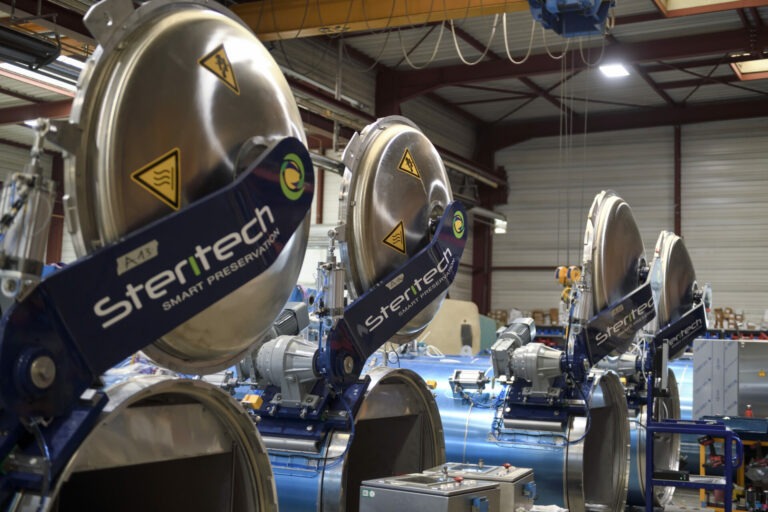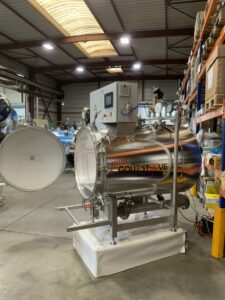
Donnerstag 27.10.22
Unser Expertenwissen Technische Beratung
Pasteurisierung und Sterilisierung: Was sind die Unterschiede?
Im Laufe der Jahrhunderte hat der Mensch die Konservierung von Lebensmitteln immer sicherer gemacht. Er erfand Techniken, um alle Bakterien und Mikroorganismen, die für seine Gesundheit schädlich sind, zu beseitigen. Pasteurisierung und Sterilisierung sind zwei Beispiele dafür. Erfahren Sie hier mehr über die Unterschiede zwischen Pasteurisierung und Sterilisierung.
Der technische Prozess der Pasteurisierung
Die Pasteurisierung wurde im 19. Jahrhundert von dem französischen Wissenschaftler Louis Pasteur erfunden und ist ein Prozess, bei dem die Temperatur für eine bestimmte Zeit erhöht wird. Das Patent für die Pasteurisierung wurde 1865 angemeldet.
Die 2 Arten der Pasteurisierung von Lebensmitteln nach ihrer Aufbewahrungstemperatur
Die Autoklaven von Steritech können zwei Arten der Pasteurisierung durchführen.
- Pasteurisierung von Produkten mit einem sauren pH-Wert von weniger als 4,5. Danach können sie bei Raumtemperatur gelagert werden.
- Pasteurisierung von Produkten mit einem pH-Wert von über 4,5. Sie müssen anschließend kühl gelagert werden.
Die Ziele der Behandlung von Lebensmitteln durch Pasteurisierung
Die Pasteurisierung ist eine Wärmebehandlung, die pathogene Bakterien in einem Produkt abtötet. Die Pasteurisierung zerstört jedoch weder bestimmte Sporen noch die resistentesten Stämme von Mikroorganismen.
- Produkte mit einem pH-Wert von weniger als 4,5: Ein Teil der pathogenen Mikroorganismen wird abgetötet. Der Säuregehalt des Produkts ermöglicht es, die Konservierung zu „vervollständigen“. Es können sich keine Mikroorganismen entwickeln.
- Produkte mit einem pH-Wert von über 4,5: Ein Teil der pathogenen Mikroorganismen (in all ihren Formen) wird abgetötet. Durch Kälte wird die Konservierung „vervollständigt“.
Die Haltbarkeit von pasteurisierten Produkten
Die Haltbarkeit von pasteurisierten Lebensmitteln hängt vomSäuregrad des Produkts ab.
- Produkte mit einem pH-Wert von weniger als 4,5: mehr als 12 Monate mit MHD (Mindesthaltbarkeitsdatum). Die Verpackung muss mit dem Hinweis „Mindestens haltbar bis“ versehen sein.
- Produkte mit einem pH-Wert von über 4,5: Dies sind verderbliche Lebensmittel. Einige Monate mit MHD (Mindesthaltbarkeitsdatum). Die Verpackung muss mit dem Hinweis „zu verbrauchen bis“ versehen sein.
Der technische Prozess der Sterilisation
Die Sterilisation ist ein temperaturbasiertes Verfahren zur Konservierung von Lebensmitteln. Je nach Sterilisationsprotokoll und -gerät kann die Erhitzungstemperatur mindestens 121 °C bei einem Druck von 100 kPa für eine vom Produkt abhängige Dauer betragen.
Die 2 Prozesse der Sterilisation von Lebensmitteln
Es gibt verschiedene Arten der Niedertemperatursterilisation (chemisch, durch UV- oder ionisierende Strahlung oder durch Filtration), die speziell für medizinische Geräte geeignet sind. Die Sterilisation von Lebensmitteln ist nur durch Hochtemperaturbehandlungen wie Autoklavieren möglich. Es gibt folgende Möglichkeiten
- Sterilisation mit trockener Hitze;
- Sterilisation durch feuchte Hitze.
Die Ziele des Sterilisationsverfahrens
Das Ziel des Sterilisationsprozesses ist es, alle Mikroben aus einer Lebensmittelzubereitung zu entfernen. Biologische Stoffe wie Sporen und pathogene Organismen werden durch die Erhöhung der Temperatur für eine bestimmte Zeit abgetötet.
Die Unterschiede zwischen Pasteurisierung und Sterilisierung
Der erste Unterschied zwischen Sterilisation und Pasteurisierung liegt in den Erfindern. Nicolas Appert entdeckte Ende des 17. Jahrhunderts, dass das Konservieren von Lebensmitteln durch Sterilisation (oder Appertisation) weniger Lebensmittelkrankheiten verursachte. Die Pasteurisierung wurde von dem französischen Arzt Louis Pasteur im darauffolgenden Jahrhundert entdeckt.
Unterschiede in der Temperatur
Bei der Sterilisation wird eine Temperatur von über 100 °C erreicht. Alle pathogenen Organismen werden abgetötet, einschließlich der Sporen. Die Konserven können dann bei Raumtemperatur aufbewahrt werden.
Im Gegensatz dazu bleibt die Pasteurisierungstemperatur unter 100 °C. Da nicht alle Mikroben abgetötet werden, müssen pasteurisierte Lebensmittel kühl gelagert werden, wenn es sich um nicht-saure Produkte handelt. Außerdem muss ein MHD (Mindesthaltbarkeitsdatum) eingehalten werden.
Die organoleptischen und ernährungsphysiologischen Eigenschaften von Lebensmitteln werden durch beide Verfahren leicht verändert.
Die Haltbarkeitsdauer der Lebensmittel in jedem Prozess
Die Haltbarkeitsdauer eines pasteurisierten Produkts ist kürzer als die eines sterilisierten Produkts. Dies liegt daran, dass die Nichtzerstörung aller pathogenen Organismen durch die Pasteurisierung zu einer kürzeren Haltbarkeit führt.
Produkte, die von jedem Verfahren betroffen sind
Die Pasteurisierungstechnik ist für alle Arten von Lebensmitteln geeignet: Milch und alle daraus hergestellten Produkte (Sahne, Butter usw.), Fruchtsäfte oder Getränke (Wein, Apfelwein oder Bier), Marmeladen und sogar Fleisch. Alle Lebensmittel können pasteurisiert werden, aber einige müssen gekühlt werden, wie z.B. Fertiggerichte.
Darüber hinaus deckt die Sterilisation eine breitere Palette von Produkten ab. Neben den bereits erwähnten Produkten sind dies auch ganze Früchte und Gemüse, Hülsenfrüchte oder Fertiggerichte.
Steritech stellt keine Maschinen zur kontinuierlichen Pasteurisierung von Fruchtsäften oder Milch her. In den meisten Fällen können Flüssigkeiten (Saft oder Milch) vor der Abfüllung in Flaschen pasteurisiert werden. Pasteurisierungstunnel sind eine weitere Lösung. Es sind Maschinen, die im Allgemeinen billiger und weniger technisch als Autoklaven sind, aber für die Pasteurisierung, die keinen Gegendruck erfordert, ausreichend sind. Unsere Maschinen können diese Produkte pasteurisieren, wobei die Flüssigkeit und die Verpackung gleichzeitig pasteurisiert werden und alles hermetisch verschlossen ist.
Unterschiedliche Behandlungsdauer und -temperaturen je nach Prozess
Sowohl bei der Sterilisation mit trockener Hitze als auch bei der Sterilisation mit feuchter Hitze sind die Dauer und die zu erreichenden Temperaturen je nach Produkt unterschiedlich. Die
Die Art der Verpackung (Behälter und Deckel), die für das Produkt geeignet ist
Sowohl das Sterilisations- als auch das Pasteurisierungsverfahren eignen sich besonders gut für verschiedene Formen von Konserven. In erster Linie werden sie für Konserven in Gläsern oder Einmachgläsern mit einem Twist-off-Deckel verwendet. Die Glasflasche kann auch verwendet werden, um z.B. Gemüsesuppen zu sterilisieren. Diese Konserven sind dann unabhängig von der Jahreszeit verwendbar.
Andere Arten vonflexiblen Verpackungen, wie Doypacks oder Plastikschalen, können ebenfalls für die Sterilisation oder Pasteurisation verwendet werden. Sie erfordern jedoch eine angemessene Steuerung des Gegendrucks im Autoklaven, um eine Verformung zu vermeiden.
Warum Pasteurisierung oder Sterilisierung?
Es wurden viele „technische“ Gründe für den Vergleich der beiden Verfahren Sterilisation und Pasteurisierung angeführt. Lassen Sie uns für einen Moment den Fokus ändern, um andere Vergleichskriterien zu untersuchen.
Ein Gewinn an Ernährungssouveränität
Neben dem Konzept der Lebensmittelsicherheit, das Steritech sehr am Herzen liegt, ist auch die Idee der Ernährungssouveränität für das Konzept der Konserven vorteilhaft. Die Variabilität der Ernten aufgrund von Klimaphänomenen (Dürren, Hitzewellen, Wassermangel oder früher Frost) ist zur Normalität geworden. Dank der Sterilisation können die Konserven bei Raumtemperatur über mehrere Jahre gelagert werden.
Umweltfreundliches Kochen und Aufbewahren
Da das Kochen gleichzeitig mit der Wärmebehandlung durchgeführt werden kann, sind die Autoklaven von Steritech „2 in 1“-Lösungen. Darüber hinaus erfordert diese Art der Konservierung bei Raumtemperatur keinen Energieverbrauch. Steritech hat sich schon immer für eine nachhaltige Entwicklung eingesetzt. Die richtigen Lösungen für die Pasteurisierung und Sterilisierungsparen Energie.
Bekämpfung der Lebensmittelverschwendung
Steritech legt großen Wert auf menschliche Werte. Das Unternehmen unterstützt junge Menschen, das Bildungswesen und verschiedene humanitäre Zwecke. Im Umweltbereich unterstützt das Unternehmen Naturschutzorganisationen. Die Verschwendung von Lebensmitteln ist ein Thema in dieser Nische. Mit Goût’stave, einem kleinen Autoklav mit großer Wirkung, trägt das Unternehmen zur Bekämpfung der Lebensmittelverschwendung bei.
Der Vorteil der Pasteurisierung im Vergleich zur Sterilisierung besteht darin, dass das Produkt bei einer niedrigeren Temperatur behandelt wird. Einige organoleptische Qualitäten (Geschmack, Farbe, Textur) bleiben somit erhalten.
Bei sauren Produkten kann dies auch eine Energie- und Kostenersparnis bedeuten. In der Tat wird die Behandlung der Produkte bei zu hohen Temperaturen vermieden. Bei nicht-sauren Produkten ist jedoch eine schnelle Abkühlung und eine Temperatur von 4 °C für die Konservierung der Produkte erforderlich, was mehr Energie für die Lagerung und den Transport erfordert.
Wählen Sie ein Unternehmen, das auf Sterilisation und Pasteurisierung spezialisiert ist.
Zögern Sie nicht, uns für Ihren Bedarf an Autoklaven zu kontaktieren. Wir führen auch Audits Ihrer Anlage durch.
Neuigkeiten von Steritech


Steritech: Industrielle Sterilisation für den Export

